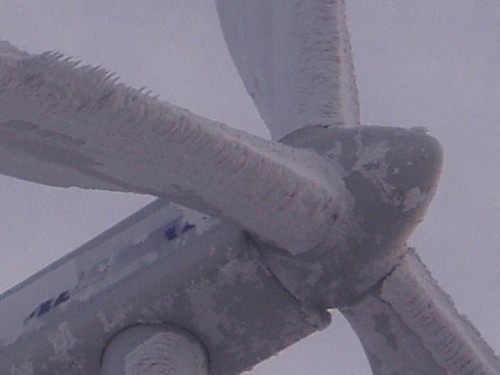Wind power is growing into a significant economic factor in Austria. In 2013 suppliers in this field notched up a turnover of more than 600 million Euro, and 1,684 MWel of new wind power capacity were installed. The Implementing Agreement “Wind Energy Systems” was launched already 1977; today 20 countries, the European Commission and the European and Chinese wind power associations collaborate on it. The experts involved exchange information on planning and implementing national wind power projects, and initiate R&D projects concerned with developing technology, commercial launches and legal frameworks. The focus is on wind power facilities of all sizes and locations (onshore and offshore), LiDAR measurements and the special conditions applying to wind power in cold climates.
In wintry weather (temperatures below 0 °C, snowfall or freezing rain) layers of ice can form on wind turbine rotor blades. Wind turbines affected by ice deliver less power, and the rotors may get out of balance, which shortens the turbine’s service life. Ice throw can also pose a serious hazard. Accordingly, modern wind turbines are equipped with an ice detection system, and must be shut down or de-iced if they ice up. Roughly 15 % of the wind farms now operating in Austria can be classified as so-called cold-climate sites, where icing is frequent. But at sites in other areas, too, icing occurs several times a year.
Since 2002, within the framework of IEA Wind Task 19, researchers have confronted the special challenges presented by wind power where icing is an issue. Austria, Canada, China, Denmark, Finland, Germany, Norway, Sweden, Switzerland and the USA are partners in this Task. The aims are to gather new insights by exchanging experience, and to build up a global network. Workshops at which national research projects are presented and discussed are held twice a year.

BOOSTING PRODUCTIVITY
with rotor blade icing management
LKR Leichtmetallkompetenzzentrum Ranshofen GmbH are pursuing a project aimed at deploying active and passive measures to minimize the negative effects of icing on wind turbines. Innovative technologies are to reduce the risk of icing and increase wind farms’ energy yield in winter. In the course of the project methods and technologies have been developed with which icing can be avoided or lessened, or ice can be removed fast and hazard-free. The approaches adopted were:
> anti-ice coatings which delay the formation of ice on rotor blades and reduce ice adhesion
> active heating by means of electricity-conductive paint on the critical portions of the rotor blades
> Fine-tuning equipment operation to reduce shutdown times
Overall the project provides a number of insights on how practicable the approaches adopted are with respect both to use in existing equipment and to standardized fabrication of new turbines; these can now be followed up and implemented.
